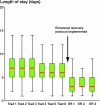Enhanced recovery program for hip and knee replacement reduces death rate
- PMID: 21895500
- PMCID: PMC3242954
- DOI: 10.3109/17453674.2011.618911
Enhanced recovery program for hip and knee replacement reduces death rate
Abstract
Background and purpose: Multimodal techniques can aid early rehabilitation and discharge of patients following primary joint replacement. We hypothesized that this not only reduces the economic burden of joint replacement by reducing length of stay, but also helps in reduction of early complications.
Patients and methods: We evaluated 4,500 consecutive unselected total hip replacements and total knee replacements regarding length of hospital stay, mortality, and perioperative complications. The first 3,000 underwent a traditional protocol while the other 1,500 underwent an enhanced recovery protocol involving behavioral, pharmacological, and procedural modifications.
Results: There was a reduction in 30-day death rate (0.5% to 0.1%, p = 0.02) and 90-day death rate (0.8% to 0.2%, p = 0.01). The median length of stay decreased from 6 days to 3 days (p < 0.001), resulting in a saving of 5,418 bed days. Requirement for blood transfusion was reduced (23% to 9.8%, p < 0.001). There was a trend of a reduced rate of 30-day myocardial infarction (0.8% to 0.5%. p = 0 .2) and stroke (0.5% to 0.2%, p = 0.2). The 60-day deep vein thrombosis figures (0.8% to 0.6%, p = 0.5) and pulmonary embolism figures (1.2% to 1.1%, p = 0.9) were similar. Re-admission rate remained unchanged during the period of the study (4.7% to 4.8%, p = 0.8).
Interpretation: This large observational study of unselected consecutive hip and knee arthroplasty patients shows a substantial reduction in death rate, reduced length of stay, and reduced transfusion requirements after the introduction of a multimodal enhanced recovery protocol.
Figures
References
-
- Andersen KV, Pfeiffer-Jensen M, Haraldsted V, Soballe K. Reduced hospital stay and narcotic consumption, and improved mobilization with local and intraarticular infiltration after hip arthroplasty: a randomized clinical trial of an intraarticular technique versus epidural infusion in 80 patients. Acta Orthop. 2007;78(2):180–6. - PubMed
-
- Andersen LO, Husted H, Otte KS, Kristensen BB, Kehlet H. A compression bandage improves local infiltration analgesia in total knee arthroplasty. Acta Orthop. 2008a;79((6)):806–11. - PubMed
-
- Andersen LO, Husted H, Otte KS, Kristensen BB, Kehlet H. High-volume infiltration analgesia in total knee arthroplasty: a randomized, double-blind, placebo-controlled trial. Acta Anaesthesiol Scand. 2008b;52(10):1331–5. - PubMed
-
- Bozic KJ, Saleh KJ, Rosenberg AG, Rubash HE. Economic evaluation in total hip arthroplasty: analysis and review of the literature. J Arthroplasty. 2004;19(2):180–9. - PubMed
-
- Danish National Board of Health D, Centre for Evaluation and Health Technology Assessment, Evaluation of patient path for patients undergoing primary total hip or knee arthroplasty. 2006.
Publication types
MeSH terms
LinkOut - more resources
Full Text Sources
Medical


